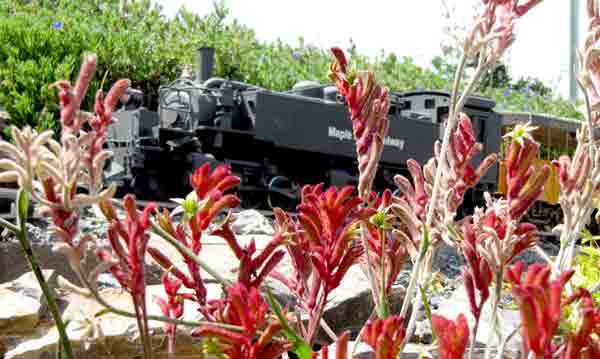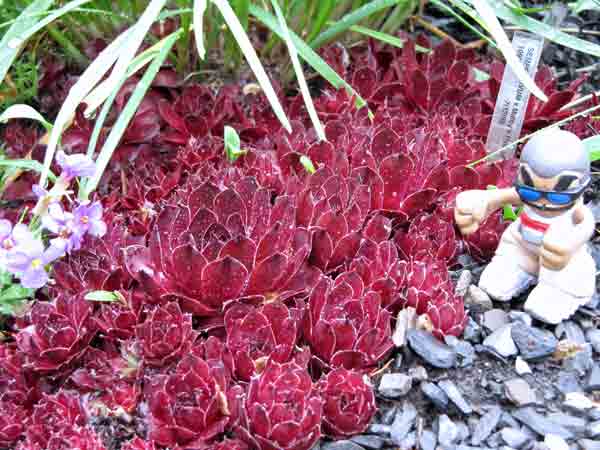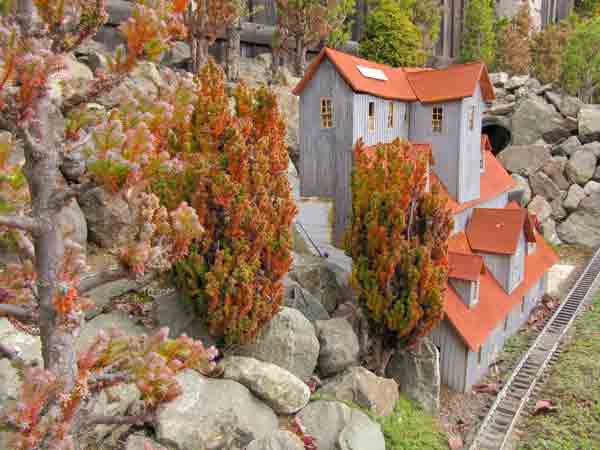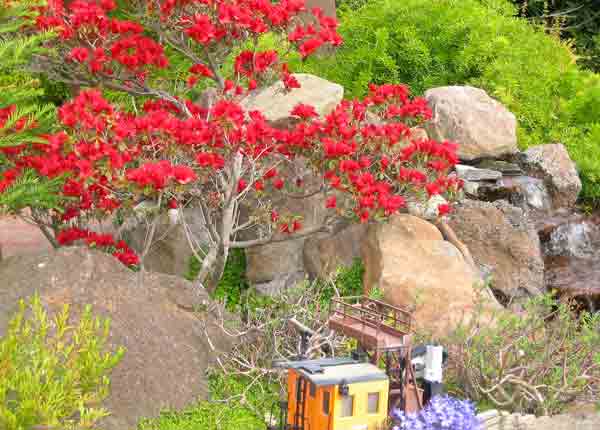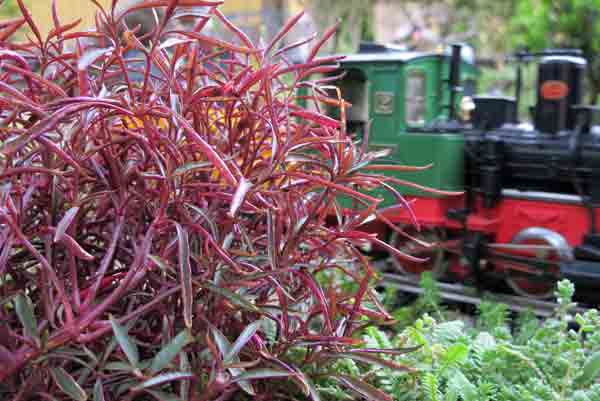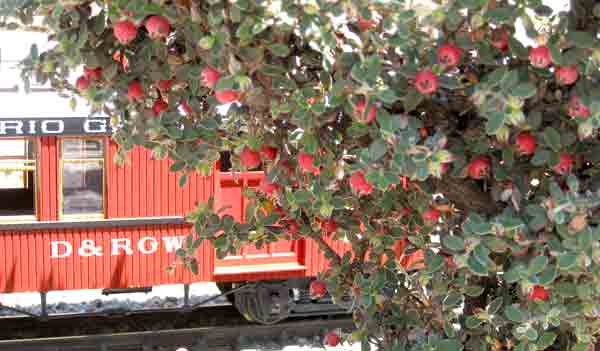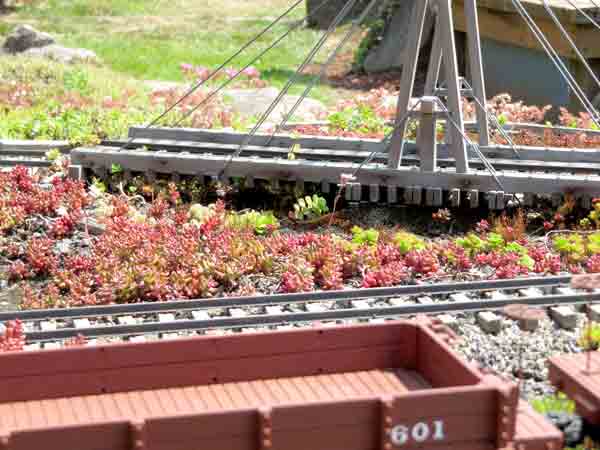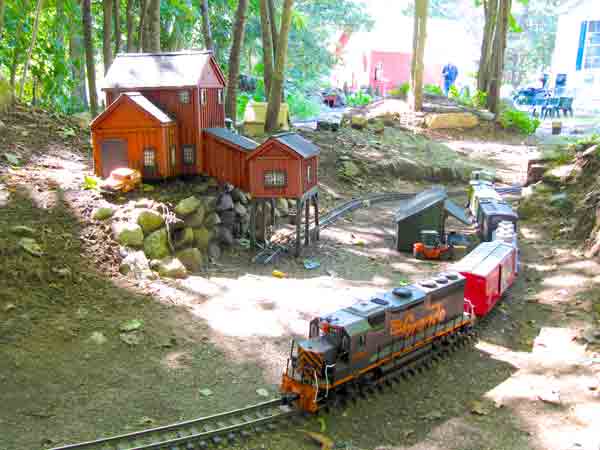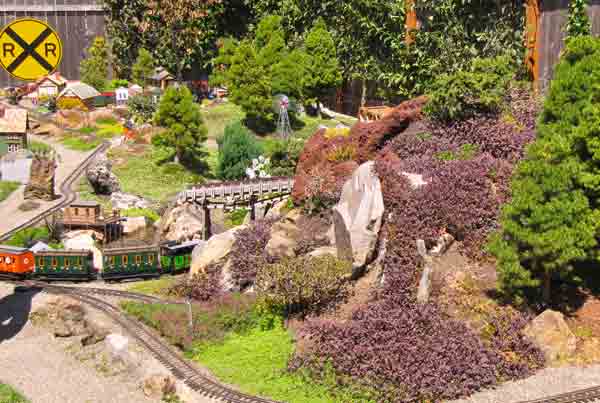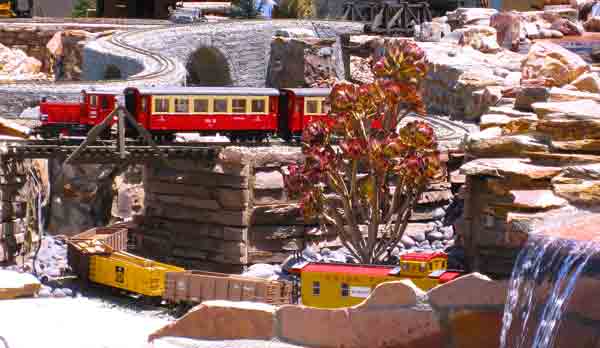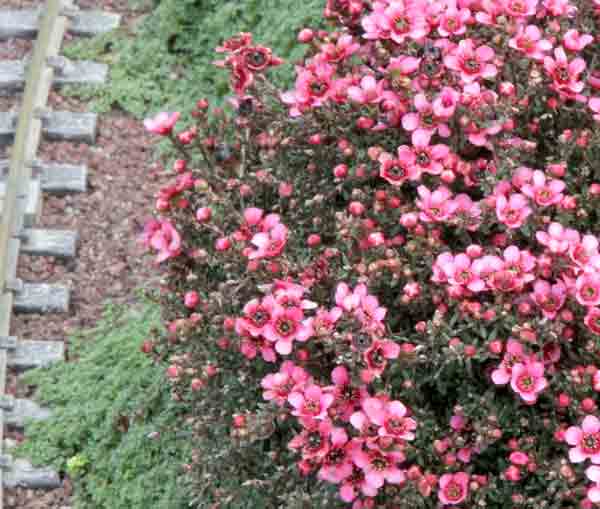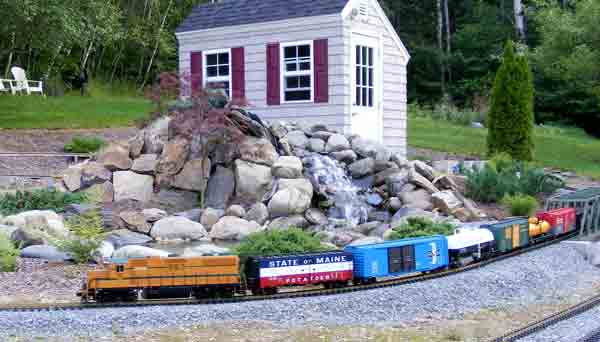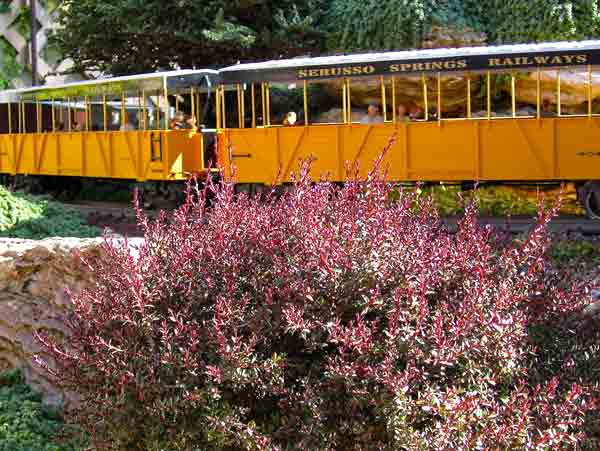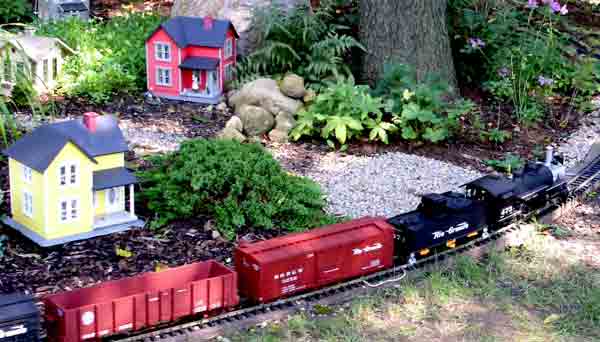Do landscape-design concepts, like coherence, ambiance, and focus, leave you puzzled? Effective designs using the strong color red will clarify ways you can emphasize elements in your railway garden. There’s nothing passive about the longest wave of the visible spectrum—red reaches out to touch your emotions, be they happy or wary. Red cries, “Stop!” or “Danger!” or “Look here!” depending on its context. It’s no cardinal rule, but wise gardeners will limit red’s presence in the railway and use just a touch.
Red carpet
Guide viewers into a scene by using red as a pointer up front. In the April issue, we looked at elements in the foreground that serve to grab your attention to start a story. Red appears larger than other colors, so red items in the front help to give perceived depth to items in the center-stage area of the railway. In photo 1, the somewhat elevated kangaroo-paw blossoms highlight your experience of the train with flying colors. Blue blossoms on the smaller-leaved plants in the rear fade away to keep the focal point in view.
Hues to choose
Bluish-green distant plants contrast with the closer crimsons to make them pop; but what if red is too much of a good thing and distracting—a red herring? Try shades of orange-red, brick-red, and wine-red to mitigate the dominance of the color that can clutch you by the collar. The bright hen-and-chicks in photo 2 seem more mellow because their purplish tone makes it easier to integrate this groundcover next to other plants. They’ll also perk up a pile of rocks.
Seasonal sensation
Every year, Mother Nature changes her painter’s palette. When the chlorophyll freezes away, you can then see the red and orange leaf pigments: the anthocyanins and carotinoids. Maples are famous for this phenomenon. Many evergreens will “burn” to a bronze blush as temperatures dip during winter (photo 3).
After the snow clears, invigorating color wakes up our awareness of the garden, and warm red does not disappoint. Azaleas deliver masses of cheerful blooms (photo 4) to welcome in a busy season. As with short-lived spring bulbs, we’re willing to tolerate slightly larger flowers, although many of the hardy azaleas (Rhododendron sp.) stay quite dwarf with small flowers. If you can provide moist acidic soil, look for R. ‘Kurume’ (Zones 5-10), R. ‘Gumpo’ (Zones 7-10), and R. ‘Satsuki’ (Zones 7-10) hybrids.
After the last frost, we can incorporate a few reddish annuals at our feet to act as a psychological barrier—a stop sign for kids and weed eaters. Some annuals or tender perennials, like the ruby-leafed alternanthera in photo 5 (perennial in Zones 10-11), may be overwintered or protected for many years of color. Late summer is apple-pickin’ time—several varieties of cotoneaster bear uncannily realistic “apples” (photo 6).
Barn siding and rail sidings
Railroad spurs play a crucial role in identifying your outdoor space as a railway. It’s not safe to leave your engines outdoors in weather, but you could leave a couple of cars near a structure to call attention to your modeled world and draw you out-of-doors to move trains (photo 7). No color excites more than red, even if a bit weathered. Let a line of red gondolas remind you of the cargo in need of transporting to that red mine building (photo 8). If your building is a long way from the viewer, bring it closer by painting it red.
Red earth
If you travel to many corners of the world, you’ll find telltale red outcroppings surrounded by neutral-colored
geological masses. As the earth’s crust formed, giant land formations were pushed up into peaks and buttes made of minerals of different origins, often iron. Reddish boulders illustrate such an event (photo 9). Some dry parts of the world, like Sedona, Arizona seem to be solid rusty-red stone, marbled with tans. An occasional creek meanders through (photo 10).
In the end, after learning some rules concerning this important manner, you can bring in your own preferences and exploit red, if it makes you happy. There is no need to fuss over placement of red plants or buildings—just plant them instinctively to satisfy your own visual taste. Red chilies and cayenne pepper can get a bit spicy and color theory can get quite complex, but as a famous color authority, Faber Birren, once said, “Color is the one experience in life that requires no conscious struggle of the intellect to appreciate.”
Where, why, and how do you use red in your railway landscape?
Paul Smith
Lincoln, Maine, Zone 4
Tricking nature
I wanted a red tree to contrast with the gray rocks and highlight the focal point of the waterfall on my railroad. This thread-leaf variety of Japanese maple, according to the tag, has best red foliage in the fall and is hardy to -10 to -20 degrees F. I left the tree in its original plastic pot (from Lowes) and found another plastic pot, about 2″ larger, which I sunk into a hole in the ground. Then I just set the potted tree into this second pot. In the fall, when all of the leaves have fallen off the tree and it is considered “dormant,” I simply lift it up out of the larger pot and transfer it to my garage, which is unheated and has little direct sunlight. Last year, I put the tree back in the ground about mid-April, when the snow and ice had completely melted out of the larger pot. The average size of this tree is 15′ high x 15′ wide but I’m hoping that, by keeping it in its original pot, it will slow the growth.
Cecil Easterday
Near Columbus, Ohio, Zone 5
Feel-good scenes
Red. I smiled when I read about this issue’s topic. Red is my happy color, a feel-good color. Like choosing a red sweater on a gray day, my plant choices for the railroad tend to be red, burgundy, and the shades in between. The color really makes a scene “pop!” There is the red car in a driveway, the red barn on the farm, the red schoolhouse, and the red flowers in the tiny window boxes. Aristo-Craft made a red farmhouse, which has been my favorite. The sun has faded it to a funny pink, but it will get a coat of red paint this year and be back in its spot.
Sue Piper
Lakeside, California, Zone 9-10
Red to green to pink
New growth on our dwarf New Zealand tea tree (Leptospermum scoparium ‘Kiwi’, Zones 9-10) emerges dark red, then turns to dark green as it matures. A couple of times a year bright-pink blossoms smother the Kiwi for a week or two—just beautiful! The only negative I have found with these plants is that, once planted in the ground, they do not like to be moved and, if they dry out at all, they won’t come back.





